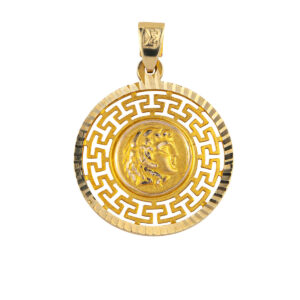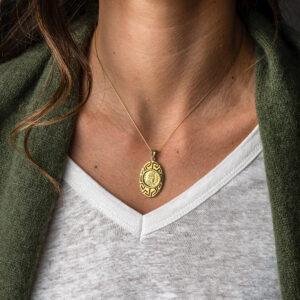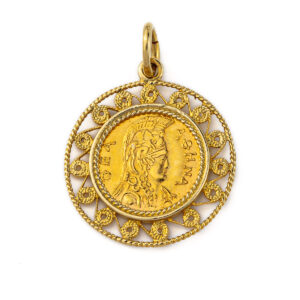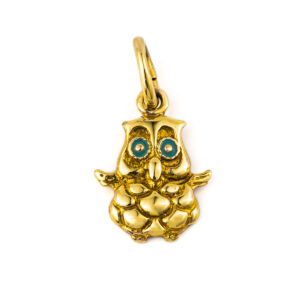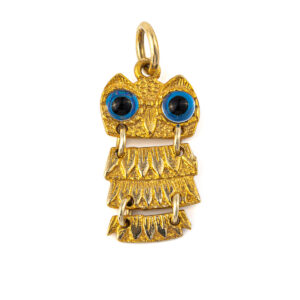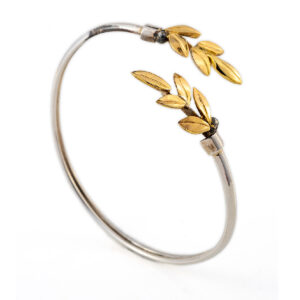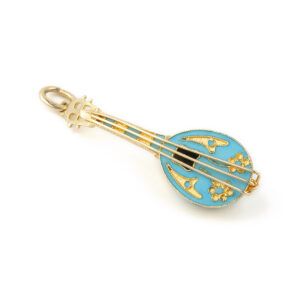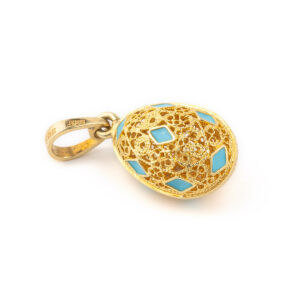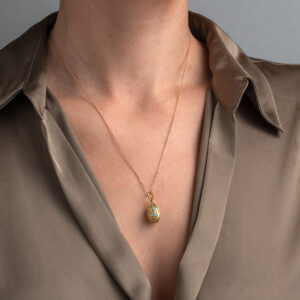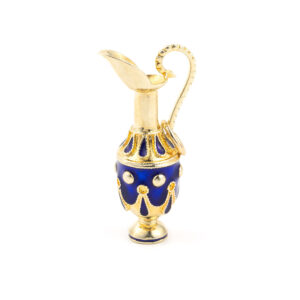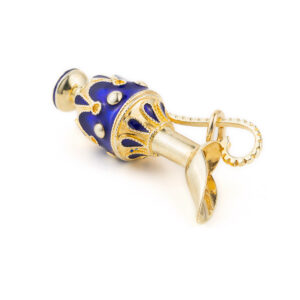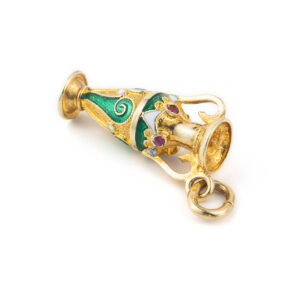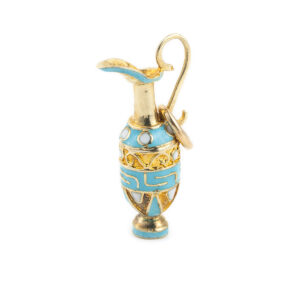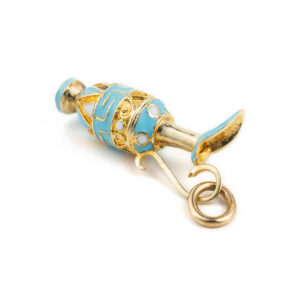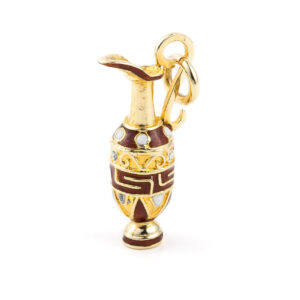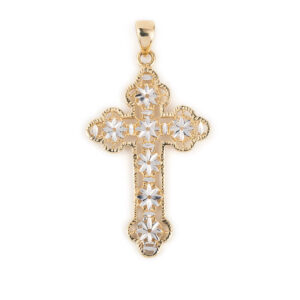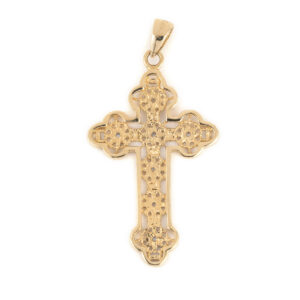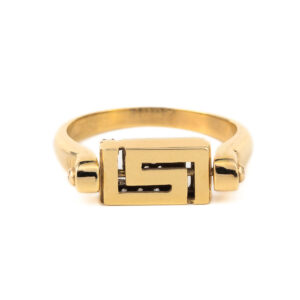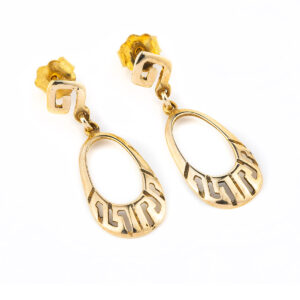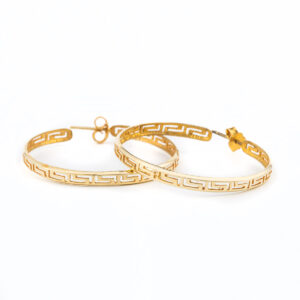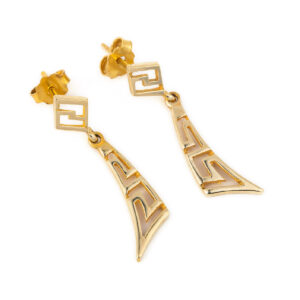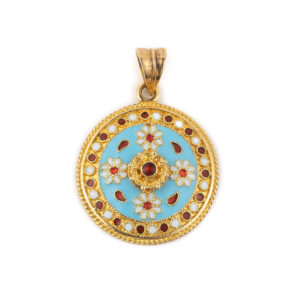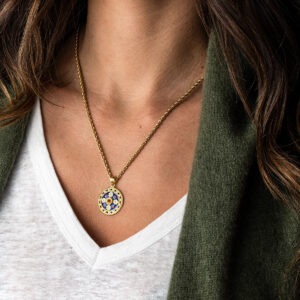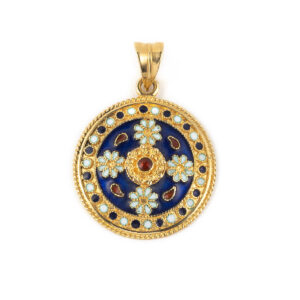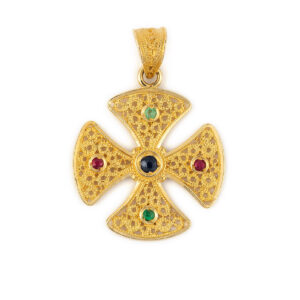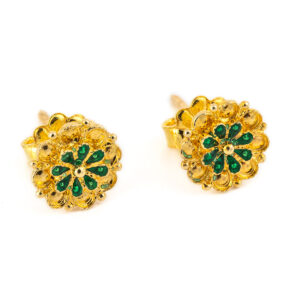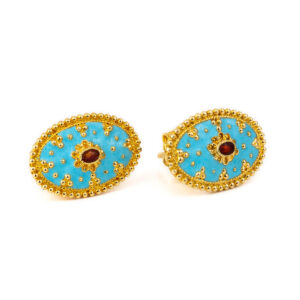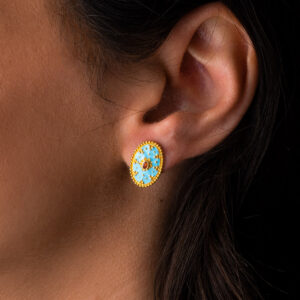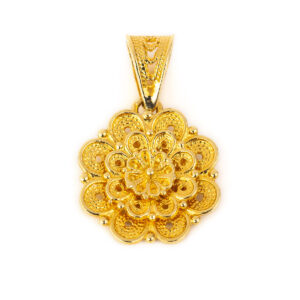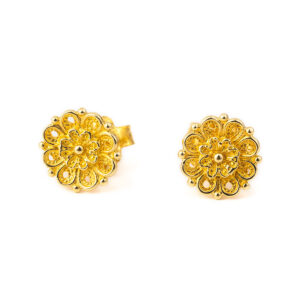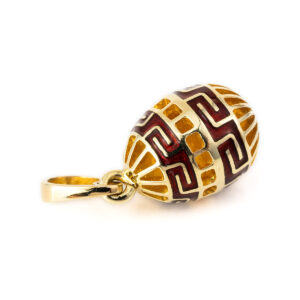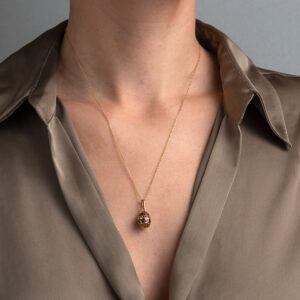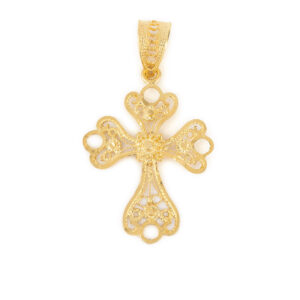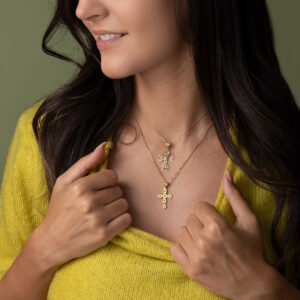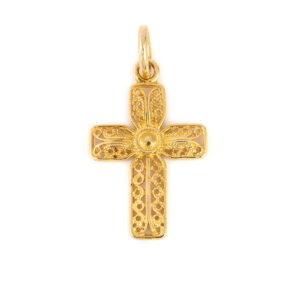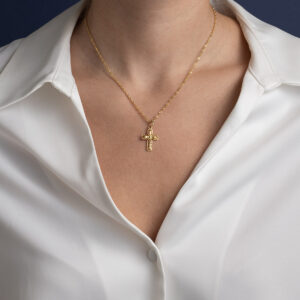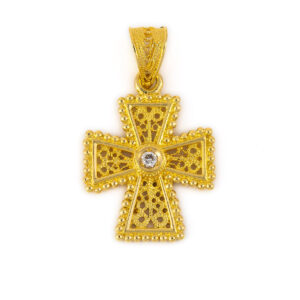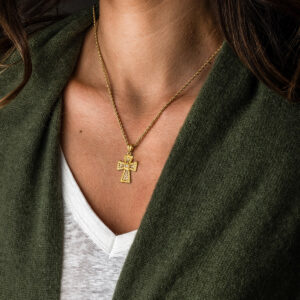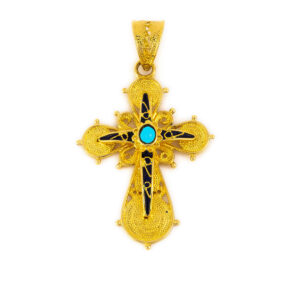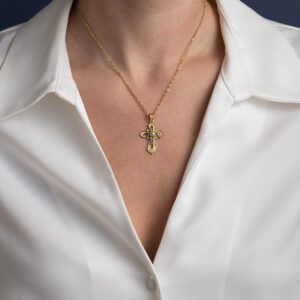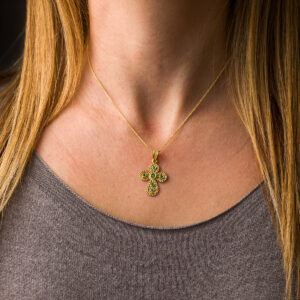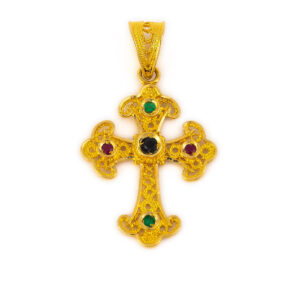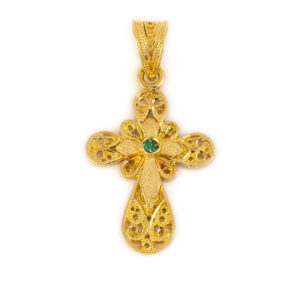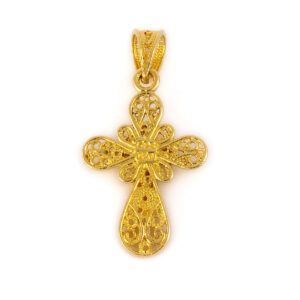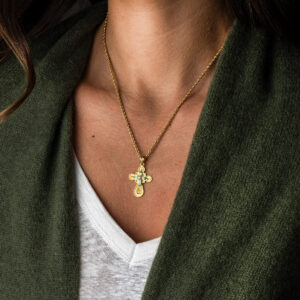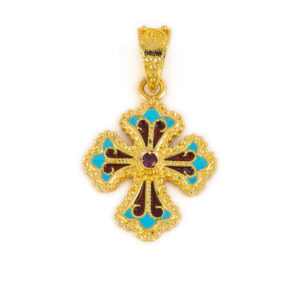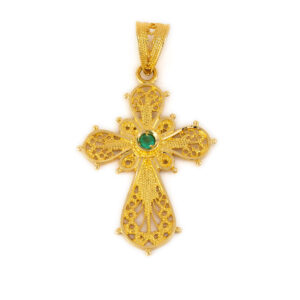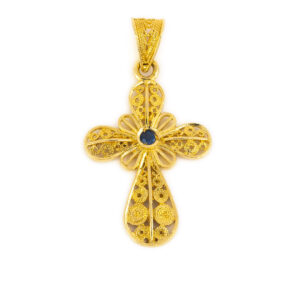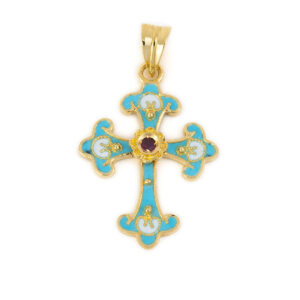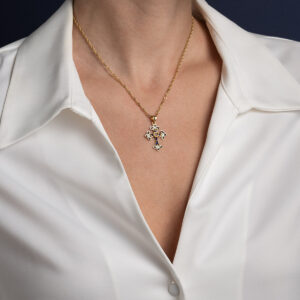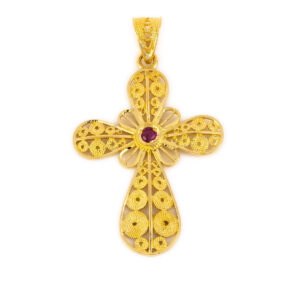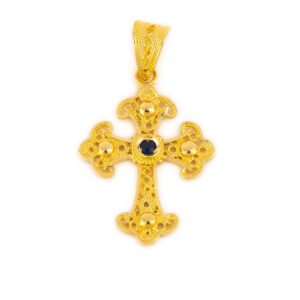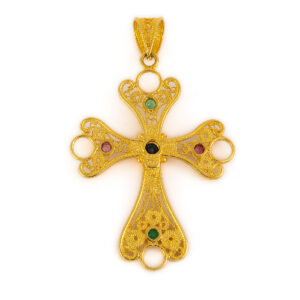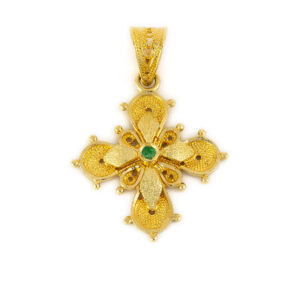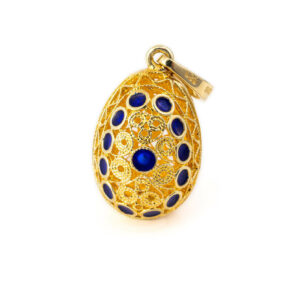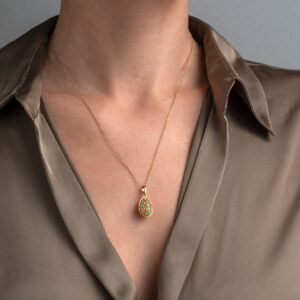Μενταγιόν με Μέγα Αλέξανδρο – Χρυσό 14Κ
708,00€Α beautiful and timeless Coin Pendant inspired by the ancient Greek tetradrachm coin of Alexander the Great.
Made of 14k gold.
This Ancient Greek coin represent the Alexander the Great. Alexander the Great the King of Macedonia is considered one of the most important forms of world history.
As in all handmade items there may be small differences in weight and dimensions and this is what makes them unique and precious.
Μενταγιόν με Αθηνά και Μαίανδρο – Χρυσό 14Κ
1.135,00€This coins illustrate the portrait of Goddess Athena on the one side and the wisdom owl on the other.
Α beautiful and timeless coin pendant.
Made of 14k gold.
Goddess Athena and Owl – Athenian silver tetradrachm.
Dracma was the currency used in Greece during several periods in its history. The tetradrachm was an Ancient Greek silver coin equivalent to fourdrachmae in Athens it replaced the earlier “heraldic” type of didrachms and it was in wide circulation from ca. 510 to ca. 38 BC. This coin belongs to the so-called “new style Athenian coins” minted between 166 and 64 B.C. and is considered one of the most popular ancient Greek coins which illustrate the portrait of Goddess Athena on the one side and the wisdom owl on the other. Athena is an ancient Greek goddess associated with wisdom, handicraft, and warfare. Athena was regarded as the patron and protectress of various cities across Greece, particularly the city of Athens, from which she most likely received her name. She’s usually shown in art wearing a helmet and holding a spear. Her major symbols include owls, olive trees, and snakes. Her temples were located atop the fortified Acropolis in the central part of the city. The Parthenon on the Athenian Acropolis is dedicated to her, along with numerous other temples and monuments. Her main festival in Athens was the Panathenaia, which was celebrated in midsummer and was the most important festival on the Athenian calendar. In the classical Olympian pantheon, Athena was regarded as the favorite daughter of Zeus. The owl traditionally accompanies Athena. Because of such association, the owl has been used as a symbol of knowledge and wisdom. The inscriptions contain the city’s “national” appellation (“ΑΘΕ», i.e. “of the Athenians”).As in all handmade items there may be small differences in weight and dimensions and this is what makes them unique and precious.
Μενταγιόν με Αθηνά και Μαίανδρο – Χρυσό 14Κ
1.029,00€This coin illustrates the portrait of Goddess Athena on the one side and the wisdom owl on the other.
Α beautiful and timeless coin pendant.
Made of 14k gold.
The chain shown is not included.
Goddess Athena and Owl – Athenian silver tetradrachm.
Dracma was the currency used in Greece during several periods in its history. The tetradrachm was an Ancient Greek silver coin equivalent to fourdrachmae in Athens it replaced the earlier “heraldic” type of didrachms and it was in wide circulation from ca. 510 to ca. 38 BC. This coin belongs to the so-called “new style Athenian coins” minted between 166 and 64 B.C. and is considered one of the most popular ancient Greek coins which illustrate the portrait of Goddess Athena on the one side and the wisdom owl on the other. Athena is an ancient Greek goddess associated with wisdom, handicraft, and warfare. Athena was regarded as the patron and protectress of various cities across Greece, particularly the city of Athens, from which she most likely received her name. She’s usually shown in art wearing a helmet and holding a spear. Her major symbols include owls, olive trees, and snakes. Her temples were located atop the fortified Acropolis in the central part of the city. The Parthenon on the Athenian Acropolis is dedicated to her, along with numerous other temples and monuments. Her main festival in Athens was the Panathenaia, which was celebrated in midsummer and was the most important festival on the Athenian calendar. In the classical Olympian pantheon, Athena was regarded as the favorite daughter of Zeus. The owl traditionally accompanies Athena. Because of such association, the owl has been used as a symbol of knowledge and wisdom. The inscriptions contain the city’s “national” appellation (“ΑΘΕ», i.e. “of the Athenians”).As in all handmade items there may be small differences in weight and dimensions and this is what makes them unique and precious.
Μενταγιόν Filigree Θεά Αθηνά – Χρυσό 14Κ
708,00€This coins illustrate the portrait of Goddess Athena on the one side and the wisdom owl on the other.
Α beautiful and timeless coin pendant.
Made of 14k gold.
The chain shown is not included.
Goddess Athena and Owl – Athenian silver tetradrachm.
Dracma was the currency used in Greece during several periods in its history. The tetradrachm was an Ancient Greek silver coin equivalent to fourdrachmae in Athens it replaced the earlier “heraldic” type of didrachms and it was in wide circulation from ca. 510 to ca. 38 BC. This coin belongs to the so-called “new style Athenian coins” minted between 166 and 64 B.C. and is considered one of the most popular ancient Greek coins which illustrate the portrait of Goddess Athena on the one side and the wisdom owl on the other. Athena is an ancient Greek goddess associated with wisdom, handicraft, and warfare. Athena was regarded as the patron and protectress of various cities across Greece, particularly the city of Athens, from which she most likely received her name. She’s usually shown in art wearing a helmet and holding a spear. Her major symbols include owls, olive trees, and snakes. Her temples were located atop the fortified Acropolis in the central part of the city. The Parthenon on the Athenian Acropolis is dedicated to her, along with numerous other temples and monuments. Her main festival in Athens was the Panathenaia, which was celebrated in midsummer and was the most important festival on the Athenian calendar. In the classical Olympian pantheon, Athena was regarded as the favorite daughter of Zeus. The owl traditionally accompanies Athena. Because of such association, the owl has been used as a symbol of knowledge and wisdom. The inscriptions contain the city’s “national” appellation (“ΑΘΕ», i.e. “of the Athenians”).As in all handmade items there may be small differences in weight and dimensions and this is what makes them unique and precious.
Μενταγιόν με Κουκουβάγια – Χρυσό 14Κ
258,00€This pendant is inspired by the Ancient Greek jewels which represent the symbol of the Wisdom Owl.
Made in 14k gold.
Owl of Athena
In Greek mythology, a little owl traditionally represents or accompanies Athena, the virgin goddess of wisdom. Because of such association, the bird – often referred to as the «owl of Athena» has been used as a symbol of knowledge, wisdom, perspicacity and erudition.
Μενταγιόν με Κουκουβάγια – Χρυσό 14Κ
449,00€This pendant is inspired by the Ancient Greek jewels which represent the symbol of the Wisdom Owl.
Made in 14k gold.
Owl of Athena
In Greek mythology, a little owl traditionally represents or accompanies Athena, the virgin goddess of wisdom. Because of such association, the bird – often referred to as the «owl of Athena» has been used as a symbol of knowledge, wisdom, perspicacity and erudition.
Βραχιόλι Ελιά – 14Κ Χρυσό και Ασήμι 925
This is a silver bracelet with 14k gold olive leaves. The olive wreath also known as kotinos was the prize for the winner at the ancient Olympic Games. It was an olive branch, of the wild- olive tree that grew at Olympia,intertwined to form a circle or a horse-shoe. According to Pausanias it was introduced by Heracles as a prize for the running race winner to honour his father Zeus. In the ancient Olympic Games there were no gold, silver, or bronze medals. There was only one winner per event, crowned with an olive wreath made of wild-olive leaves from a sacred tree near the temple of Zeus at Olympia. Olive wreaths were given out during the 2004 Summer Olympics in Athens in honor of the ancient tradition, because the games were being held in Greece.
The bracelet is bendable.
Handmade item.
Μενταγιόν Μπουζούκι – 14Κ Χρυσό
920,00€Greek Bouzouki Charm with turquoise enamel. The pendant is decorated with rosette motifs.
Made in 14k yellow gold.
Used as a charm or as a pendant.
Design inspired by the Greek tradition
The Greek bouzouki is a plucked musical instrument of the lute family, called the thabouras or tambouras family. The tambouras has existed in ancient Greece as pandoura, and can be found in various sizes and shapes. The bouzouki and the baglamas are the direct descendants. The bouzouki arrived in Greece following the 1919–1922 war in Asia Minor and the subsequent exchange of populations between Greece and Turkey when the ethnic Greeks fled to Greece. At the end of the 1950s, four-course (tetrachordo) bouzoukia started to gain popularity. The four-course bouzouki was made popular by Manolis Chiotis. Manolis Chiotis was a Greek rebetiko and laiko composer, singer, and bouzouki player. He is considered one of the greatest bouzouki soloists of all time. In the summer of 1961, he played for Aristotle Onassis and Maria Callas and Grace Kelly. Callas told Chiotis that she had been translating the lyrics of his songs to Princess Grace all night long and the American actress loved them because “she is a woman in love.” At that moment, Kelly asked Chiotis what the difference between a bouzouki and an electric guitar is. Chiotis’ answer was rather unexpected; “Mrs. Callas, please explain to Princess Grace that the strings of an electric guitar vibrate due to electricity, while the strings of a bouzouki vibrate through the heart.” *
The rosette (rose) is a timeless jewel, symbol and amulet. The origin of the term is the Greek word for rose – rodon (ρόδον). Its use began in the Mycenaean era and continues as far as the 2nd millennia BC. The Mycenaean Rosette is a motif that was widespread throughout Mesopotamia, Egypt, Greece and other ancient civilizations. Rosette or Rodax was probably the most popular and favorite decorative element in Mycenaean era, classical antiquity and Byzantine times.
Μενταγιόν Αμφορέας – 14Κ Χρυσό
1.648,00€Ancient Greek Amphora Pendant with blue enamel.
Design inspired by the ancient Greek history.
Made in 14k yellow gold
Also available with turquoise or green enamel
Handmade item
Amphora is a Greco – Roman word developed in ancient Greek during the Bronze Age. An amphora is a type of container of a characteristic shape and size. Amphorae were used for the transport and storage of various products, both liquid and dry, but mostly for wine. They are most often ceramic. the amphorae used in Ancient Greek vase painting. (source wikipedia)
Μενταγιόν Αμφορέας – 14Κ Χρυσό
592,00€Ancient Greek Amphora Pendant with turquoise enamel.
Design inspired by the ancient Greek history.
Made in 14k yellow gold
Also available with red or green enamel
Handmade item
Amphora is a Greco – Roman word developed in ancient Greek during the Bronze Age. An amphora is a type of container of a characteristic shape and size. Amphorae were used for the transport and storage of various products, both liquid and dry, but mostly for wine. They are most often ceramic. the amphorae used in Ancient Greek vase painting.
Μενταγιόν Αμφορέας – 14Κ Χρυσό
620,00€Ancient Greek Amphora Pendant with green enamel.
Design inspired by the ancient Greek history.
Made in 14k yellow gold
Also available with red or turquoise enamel
Handmade item
Amphora is a Greco – Roman word developed in ancient Greek during the Bronze Age. An amphora is a type of container of a characteristic shape and size. Amphorae were used for the transport and storage of various products, both liquid and dry, but mostly for wine. They are most often ceramic. the amphorae used in Ancient Greek vase painting. (source wikipedia)
Μενταγιόν Αμφορέας – 14Κ Χρυσό
592,00€Ancient Greek Amphora Pendant with Turquoise enamel and Meander design.
Design inspired by the ancient Greek history.
Made in 14k yellow gold
Also available with red or blue enamel
Available in 3 sizes
Handmade item
Amphora is a Greco – Roman word developed in ancient Greek during the Bronze Age. An amphora is a type of container of a characteristic shape and size. Amphorae were used for the transport and storage of various products, both liquid and dry, but mostly for wine. They are most often ceramic. the amphorae used in Ancient Greek vase painting. (source wikipedia)
Meander or Meandros design, one of the most historic symbols of the Greek World, also called Greek Key and symbolizes long life and eternity. The pattern with Meander was used in antiquity to decorate the frieze of temples.
Μενταγιόν Αμφορέας – 14Κ Χρυσό
620,00€Ancient Greek Amphora Pendant with red enamel and Meander design.
Design inspired by the ancient Greek history.
Made in 14k yellow gold
Also available with turquoise or blue enamel
Available in 3 sizes.
Handmade item.
The chain shown is our 14K Gold Chain (not included).
Amphora is a Greco – Roman word developed in ancient Greek during the Bronze Age. An amphora is a type of container of a characteristic shape and size. Amphorae were used for the transport and storage of various products, both liquid and dry, but mostly for wine. They are most often ceramic. the amphorae used in Ancient Greek vase painting. (source wikipedia)
Meander or Meandros design, one of the most historic symbols of the Greek World, also called Greek Key and symbolizes long life and eternity. The pattern with Meander was used in antiquity to decorate the frieze of temples.
Βυζαντινός Σταυρός – Χρυσό 14Κ
364,00€Byzantine Cross
Inspired by Byzantine art.
Made in 14k gold
Handmade item
Δαχτυλίδι Μαίανδρος – 14Κ Χρυσό
792,00€Meander Ring in 14k Gold with white crystals inspired by the ancient Greek design the Meander or Greek Key.
Meandros design is a decorative border constructed from a continuous line, shaped into a repeated motif. Such a design is also called the Greek fret or Greek key design, although these are modern designations. One the one hand, the name “meander” recalls the twisting and turning path of the Meander River in Asia Minor, and on the other hand, as Karl Kerenyi pointed out, “the meander is the figure of a labyrinth in linear form” the meaning is that these is no beginning and to end in some cases so it become the symbol of long life and eternity.
Handmade item.
Δαχτυλίδι Μαίανδρος – 14Κ Χρυσό
920,00€Ring inspired by the ancient Greek design the Meander or Greek Key.
Made of 14k Gold
Meandros design is a decorative border constructed from a continuous line, shaped into a repeated motif. Such a design is also called the Greek fret or Greek key design, although these are modern designations. One the one hand, the name “meander” recalls the twisting and turning path of the Meander River in Asia Minor, and on the other hand, as Karl Kerenyi pointed out, “the meander is the figure of a labyrinth in linear form” the meaning is that these is no beginning and to end in some cases so it become the symbol of long life and eternity.
As in all handmade items there may be small differences in weight and dimensions and this is what makes them unique and precious.
Σκουλαρίκια με Μαίανδρο – 14Κ Χρυσο
495,00€14k Gold Meander Earrings.
Meandros design is a decorative border constructed from a continuous line, shaped into a repeated motif. Such a design is also called the Greek fret or Greek key design, although these are modern designations. One the one hand, the name “meander” recalls the twisting and turning path of the Meander River in Asia Minor, and on the other hand, as Karl Kerenyi pointed out, “the meander is the figure of a labyrinth in linear form” the meaning is that these is no beginning and to end in some cases so it become the symbol of long life and eternity.
Handmade item.
Σκουλαρίκια Κρίκοι με Μαίανδρο – 14Κ Χρυσό
1.136,00€14k Gold Meander Earrings.
Meandros design is a decorative border constructed from a continuous line, shaped into a repeated motif. Such a design is also called the Greek fret or Greek key design, although these are modern designations. One the one hand, the name “meander” recalls the twisting and turning path of the Meander River in Asia Minor, and on the other hand, as Karl Kerenyi pointed out, “the meander is the figure of a labyrinth in linear form” the meaning is that these is no beginning and to end in some cases so it become the symbol of long life and eternity.
Handmade item.
Σκουλαρίκια Σταγόνα με Μαίανδρο – 14Κ Χρυσό
556,00€14K Gold Meander Dangling Earrings
Meandros design is a decorative border constructed from a continuous line, shaped into a repeated motif. Such a design is also called the Greek fret or Greek key design, although these are modern designations. One the one hand, the name “meander” recalls the twisting and turning path of the Meander River in Asia Minor, and on the other hand, as Karl Kerenyi pointed out, “the meander is the figure of a labyrinth in linear form” the meaning is that these is no beginning and to end in some cases so it become the symbol of long life and eternity.
Handmade item.
Σκουλαρίκια Μαίανδρος – 14Κ Χρυσο
665,00€Gold Geometrical Meander Earrings.
Meandros design is a decorative border constructed from a continuous line, shaped into a repeated motif. Such a design is also called the Greek fret or Greek key design, although these are modern designations. One the one hand, the name “meander” recalls the twisting and turning path of the Meander River in Asia Minor, and on the other hand, as Karl Kerenyi pointed out, “the meaning is that these is no beginning and to end end in some cases so it become thwe symbol of long life and eternity.
Handmade item.
18Κ Χρυσό Τυρκουάζ Μενταγιόν με Αρχαια Ελληνική Ροζέτα
1.368,00€Αρχαίο Ελληνικό Στρογγυλό Μενταγιόν με φλοράλ μοτίβο (τέσσερα μοτίβα ροζέτα). Το μενταγιόν είναι διακοσμημένο με τυρκουάζ & κόκκινο σμάλτο και κόκκους πολύτιμου μετάλλου. Η πίσω πλευρά του μενταγιόν δεν έχει διακόσμηση.
Σχεδιασμός εμπνευσμένος από την απίστευτη ομορφιά της ιστορικής παράδοσης.
Από χρυσό 18 καρατίων.
Διατίθεται επίσης με μπλε σμάλτο.
Χειροποίητο ελληνικό κόσμημα.
Η αλυσίδα που απεικονίζεται είναι η 14K χρυσή αλυσίδα rope (δεν περιλαμβάνεται).
Ο ροζέτα (τριαντάφυλλο) είναι ένα διαχρονικό κόσμημα, σύμβολο και φυλαχτό.
Η προέλευση του όρου είναι η ελληνική λέξη για το τριαντάφυλλο – rodon (ρόδον). Η χρήση του ξεκίνησε στη μυκηναϊκή εποχή και συνεχίζεται μέχρι τη 2η χιλιετία π.Χ. Η μυκηναϊκή ρόδα είναι ένα μοτίβο που ήταν ευρέως διαδεδομένο σε όλη τη Μεσοποταμία, την Αίγυπτο, την Ελλάδα και άλλους αρχαίους πολιτισμούς. Είναι εμπνευσμένο από μια χάντρα με μυκηναϊκή ροζέτα, που βρέθηκε στις Μυκήνες και χρονολογείται στο 1400-1300 π.Χ. Η ροζέτα χρησιμοποιήθηκε εκτενώς στα αρχαία ελληνικά μυκηναϊκά κοσμήματα, στην αρχιτεκτονική, στην κεραμική και στα γλυπτά από το 1500 π.Χ. Οι μυκηναϊκοί ρόδακες είχαν συνήθως 6 ή 8 ή 12 φύλλα και δεκαέξι φύλλα κατά τη διάρκεια της Μακεδονικής Δυναστείας. Τέτοιες λεπτομέρειες όπως το σχήμα του ρόδακα και ο αριθμός των φύλλων τείνουν να ποικίλλουν ανάλογα με την εποχή ή τις δοξασίες. Οι ρόδακες χρησιμοποιούνταν για τη διακόσμηση των υφασμάτων, των ζωνών και των στεφάνων των βασιλέων. Ο αριθμός των φύλλων είχε συμβολικό χαρακτήρα κάθε φορά. Τα τέσσερα στοιχεία της φύσης (άνεμος, γη, φωτιά, νερό), τα επτά θαύματα του αρχαίου κόσμου ή οι δώδεκα θεοί των αρχαίων Ελλήνων και η παγκόσμια κυριαρχία και ακτινοβολία των βασιλιάδων της Μακεδονίας. Ήταν σημάδια ομορφιάς, αγνότητας, ευζωίας, λατρείας και εξουσίας. Η ροζέτα ή ρόδαξ ήταν ίσως το πιο δημοφιλές και αγαπημένο διακοσμητικό στοιχείο στη μυκηναϊκή εποχή, την κλασική αρχαιότητα και τους βυζαντινούς χρόνους.
18Κ Χρυσό Μπλε Μενταγιόν με Αρχαια Ελληνική Ροζέτα
1.436,00€Αρχαίο Ελληνικό Στρογγυλό Μενταγιόν με φλοράλ μοτίβο (τέσσερα μοτίβα ροζέτα). Το μενταγιόν είναι διακοσμημένο με τυρκουάζ & κόκκινο σμάλτο και κόκκους πολύτιμου μετάλλου. Η πίσω πλευρά του μενταγιόν δεν έχει διακόσμηση.
Σχεδιασμός εμπνευσμένος από την απίστευτη ομορφιά της ιστορικής παράδοσης.
Από χρυσό 18 καρατίων.
Διατίθεται επίσης με τυρκουάζ σμάλτο.
Χειροποίητο ελληνικό κόσμημα.
Η αλυσίδα που απεικονίζεται είναι η 14K χρυσή αλυσίδα rope (δεν περιλαμβάνεται).
Ο ροζέτα (τριαντάφυλλο) είναι ένα διαχρονικό κόσμημα, σύμβολο και φυλαχτό.
Η προέλευση του όρου είναι η ελληνική λέξη για το τριαντάφυλλο – rodon (ρόδον). Η χρήση του ξεκίνησε στη μυκηναϊκή εποχή και συνεχίζεται μέχρι τη 2η χιλιετία π.Χ. Η μυκηναϊκή ρόδα είναι ένα μοτίβο που ήταν ευρέως διαδεδομένο σε όλη τη Μεσοποταμία, την Αίγυπτο, την Ελλάδα και άλλους αρχαίους πολιτισμούς. Είναι εμπνευσμένο από μια χάντρα με μυκηναϊκή ροζέτα, που βρέθηκε στις Μυκήνες και χρονολογείται στο 1400-1300 π.Χ. Η ροζέτα χρησιμοποιήθηκε εκτενώς στα αρχαία ελληνικά μυκηναϊκά κοσμήματα, στην αρχιτεκτονική, στην κεραμική και στα γλυπτά από το 1500 π.Χ. Οι μυκηναϊκοί ρόδακες είχαν συνήθως 6 ή 8 ή 12 φύλλα και δεκαέξι φύλλα κατά τη διάρκεια της Μακεδονικής Δυναστείας. Τέτοιες λεπτομέρειες όπως το σχήμα του ρόδακα και ο αριθμός των φύλλων τείνουν να ποικίλλουν ανάλογα με την εποχή ή τις δοξασίες. Οι ρόδακες χρησιμοποιούνταν για τη διακόσμηση των υφασμάτων, των ζωνών και των στεφάνων των βασιλέων. Ο αριθμός των φύλλων είχε συμβολικό χαρακτήρα κάθε φορά. Τα τέσσερα στοιχεία της φύσης (άνεμος, γη, φωτιά, νερό), τα επτά θαύματα του αρχαίου κόσμου ή οι δώδεκα θεοί των αρχαίων Ελλήνων και η παγκόσμια κυριαρχία και ακτινοβολία των βασιλιάδων της Μακεδονίας. Ήταν σημάδια ομορφιάς, αγνότητας, ευζωίας, λατρείας και εξουσίας. Η ροζέτα ή ρόδαξ ήταν ίσως το πιο δημοφιλές και αγαπημένο διακοσμητικό στοιχείο στη μυκηναϊκή εποχή, την κλασική αρχαιότητα και τους βυζαντινούς χρόνους.
18ΚΤ Χρυσός Βυζαντινός Σταυρός με ρουμπίνια σμαράγδια και ζαφείρια
1.007,00€18ΚΤ Χρυσός Βυζαντινός Σταυρός με ρουμπίνια σμαράγδια και ζαφείρια
Εμπνευσμένος από τη βυζαντινή τέχνη.
Κατασκευασμένος από χρυσό 18 καρατίων
Χειροποίητο ελληνικό κόσμημα.
Η αλυσίδα που απεικονίζεται είναι η 14Κ χρυσή αλυσίδα rope(δεν περιλαμβάνεται).
Όπως σε όλα τα χειροποίητα αντικείμενα, μπορεί να υπάρχουν μικρές διαφορές στο βάρος και τις διαστάσεις και αυτό είναι που τα κάνει μοναδικά και πολύτιμα.
Καρφωτά Σκουλαρίκια με Βυζαντινή Ροζέτα από Χρυσό 18Κ
480,00€Βυζαντινά σκουλαρίκια που έχουν το σχήμα της ροζέτας λουλουδιών.
Χειροποίητα με μεγάλη προσοχή στη λεπτομέρεια. Εμπνευσμένα από τη βυζαντινή τέχνη.
Από χρυσό 18 καρατίων και σμάλτο τυρκουάζ.
Λουλούδι ροζέτα
Η ροζέτα (τριαντάφυλλο) είναι ένα διαχρονικό κόσμημα, σύμβολο και φυλαχτό. Η προέλευση του όρου είναι η ελληνική λέξη για το τριαντάφυλλο – ρόδων (ρόδον). Η χρήση του ξεκίνησε από τη μυκηναϊκή εποχή και συνεχίζεται μέχρι και τη 2η χιλιετία π.Χ. Η μυκηναϊκή ρόδα είναι ένα μοτίβο που ήταν ευρέως διαδεδομένο σε όλη τη Μεσοποταμία, την Αίγυπτο, την Ελλάδα και άλλους αρχαίους πολιτισμούς. Είναι εμπνευσμένο από μια χάντρα με μυκηναϊκή ροζέτα, που βρέθηκε στις Μυκήνες και χρονολογείται στο 1400-1300 π.Χ. Η ροζέτα χρησιμοποιήθηκε εκτενώς στα αρχαία ελληνικά μυκηναϊκά κοσμήματα, στην αρχιτεκτονική, στην κεραμική και στα γλυπτά από το 1500 π.Χ. Οι μυκηναϊκοί ρόδακες είχαν συνήθως 6 ή 8 ή 12 φύλλα και δεκαέξι φύλλα κατά τη διάρκεια της Μακεδονικής Δυναστείας. Τέτοιες λεπτομέρειες όπως το σχήμα του ρόδακα και ο αριθμός των φύλλων τείνουν να ποικίλλουν ανάλογα με την εποχή ή τις δοξασίες. Οι ρόδακες χρησιμοποιούνταν για τη διακόσμηση των υφασμάτων, των ζωνών και των στεφάνων των βασιλέων. Ο αριθμός των φύλλων είχε συμβολικό χαρακτήρα κάθε φορά. Τα τέσσερα στοιχεία της φύσης (άνεμος, γη, φωτιά, νερό), τα επτά θαύματα του αρχαίου κόσμου ή οι δώδεκα θεοί των αρχαίων Ελλήνων και η παγκόσμια κυριαρχία και ακτινοβολία των βασιλιάδων της Μακεδονίας. Ήταν σημάδια ομορφιάς, αγνότητας, ευζωίας, λατρείας και εξουσίας. Η ροζέτα ή ρόδαξ ήταν ίσως το πιο δημοφιλές και αγαπημένο διακοσμητικό στοιχείο στη μυκηναϊκή εποχή, την κλασική αρχαιότητα και τους βυζαντινούς χρόνους.
18K Gold and Green Enamel Rosette Stud Earrings
504,00€Byzantine Earrings which have the shape of the flower rosette.
Handmade with the great attention to detail. Inspired by Byzantine art.
Made in 18k gold and green enamel
Rosette flower
The rosette (rose) is a timeless jewel, symbol and amulet. The origin of the term is the Greek word for rose – rodon (ρόδον). Its use began in the Mycenaean era and continues as far as the 2nd millennia BC. The Mycenaean Rosette is a motif that was widespread throughout Mesopotamia, Egypt, Greece and other ancient civilizations. It is inspired by a Mycenaean rosette bead, found at Mycenae, dated to 1400-1300 B.C. The rosette were used extensively in ancient Greek Mycenaean jewels, in architecture, pottery and in sculptures from 1500 BC. Mycenaean rosettes usually had 6 or 8 or 12 leaves, and sixteen leaves during the Macedonian Dynasty. Such details as the rodax shape and the number of leaves tend to vary with the era or beliefs. The rosettes were used to decorate the cloths, the belts and wreaths of the Kings. The number of leaves had a symbolic character each time. The four elements of nature (wind, earth, fire, water), the seven wonders of the ancient world or the twelve gods of ancient Greeks and the world domination and radiance of the Kings of Macedonia. They were signs of beauty, purity, eugenics, worship and power. Rosette or Rodax was probably the most popular and favorite decorative element in Mycenaean era, classical antiquity and Byzantine times.
18Κ Χρυσά Σκουλαρίκια με Τυρκουάζ Σμάλτο
1.108,00€Βυζαντινά σκουλαρίκια διακοσμημένα με λεπτό φιλιγκράν και κόκκους από πολύτιμο μέταλλο.
Χειροποίητο ελληνικό κόσμημα με μεγάλη προσοχή στη λεπτομέρεια. Εμπνευσμένο από τη βυζαντινή τέχνη.
Από χρυσό 18 καρατίων.
Η κοκκοποίηση (από τα λατινικά: granum = «κόκκος») είναι μια τεχνική κοσμηματοποιίας με την οποία η επιφάνεια ενός κοσμήματος καλύπτεται με μικρές σφαίρες ή κόκκους πολύτιμου μετάλλου. Η τεχνική θεωρείται ότι έχει τις ρίζες της στη Μεσοποταμία πριν από περίπου 5.000 χρόνια.
18K Χρυσό Μενταγιόν Φιλιγκράν Βυζαντινής Ροζέτας
535,00€18K Χρυσό Μενταγιόν Φιλιγκράν Βυζαντινής Ροζέτας
Βυζαντινό κρεμαστό κόσμημα που έχει το σχήμα της ροζέτας λουλουδιών. Αυτό το κρεμαστό κόσμημα είναι διακοσμημένο με λεπτό φιλιγκράν και κόκκους πολύτιμου μετάλλου.
Χειροποίητο ελληνικό κόσμημα με μεγάλη προσοχή στη λεπτομέρεια.
Εμπνευσμένο από τη βυζαντινή τέχνη.
Κατασκευασμένο από χρυσό 18 καρατίων
Ανθος Ροζέτα
Η ροζέτα (τριαντάφυλλο) είναι ένα διαχρονικό κόσμημα, σύμβολο και φυλαχτό. Η προέλευση του όρου είναι η ελληνική λέξη για το τριαντάφυλλο – ρόδων (ρόδον). Η χρήση του ξεκίνησε στη μυκηναϊκή εποχή και συνεχίζεται μέχρι τη 2η χιλιετία π.Χ. Η μυκηναϊκή ρόδα είναι ένα μοτίβο που ήταν ευρέως διαδεδομένο σε όλη τη Μεσοποταμία, την Αίγυπτο, την Ελλάδα και άλλους αρχαίους πολιτισμούς. Είναι εμπνευσμένο από μια χάντρα με μυκηναϊκή ροζέτα, που βρέθηκε στις Μυκήνες και χρονολογείται στο 1400-1300 π.Χ. Η ροζέτα χρησιμοποιήθηκε εκτενώς στα αρχαία ελληνικά μυκηναϊκά κοσμήματα, στην αρχιτεκτονική, στην κεραμική και στα γλυπτά από το 1500 π.Χ. Οι μυκηναϊκοί ρόδακες είχαν συνήθως 6 ή 8 ή 12 φύλλα και δεκαέξι φύλλα κατά τη διάρκεια της Μακεδονικής Δυναστείας. Τέτοιες λεπτομέρειες όπως το σχήμα του ρόδακα και ο αριθμός των φύλλων τείνουν να ποικίλλουν ανάλογα με την εποχή ή τις δοξασίες. Οι ρόδακες χρησιμοποιούνταν για τη διακόσμηση των υφασμάτων, των ζωνών και των στεφάνων των βασιλέων. Ο αριθμός των φύλλων είχε συμβολικό χαρακτήρα κάθε φορά. Τα τέσσερα στοιχεία της φύσης (άνεμος, γη, φωτιά, νερό), τα επτά θαύματα του αρχαίου κόσμου ή οι δώδεκα θεοί των αρχαίων Ελλήνων και η παγκόσμια κυριαρχία και ακτινοβολία των βασιλιάδων της Μακεδονίας. Ήταν σημάδια ομορφιάς, αγνότητας, ευζωίας, λατρείας και εξουσίας. Η ροζέτα ή ρόδαξ ήταν ίσως το πιο δημοφιλές και αγαπημένο διακοσμητικό στοιχείο στη μυκηναϊκή εποχή, την κλασική αρχαιότητα και τους βυζαντινούς χρόνους.
Η κοκκοποίηση (από τα λατινικά: granum = «κόκκος») είναι μια τεχνική κοσμηματοποιίας με την οποία η επιφάνεια ενός κοσμήματος καλύπτεται με μικρές σφαίρες ή κόκκους πολύτιμου μετάλλου. Η τεχνική θεωρείται ότι έχει τις ρίζες της στη Μεσοποταμία πριν από περίπου 5.000 χρόνια
Το φιλιγκράν είναι ένα λεπτό είδος μεταλλικής κοσμηματοποιίας, κατασκευασμένο με μικροσκοπικές χάντρες ή στριφτά νήματα, ή και τα δύο σε συνδυασμό, συγκολλημένα μεταξύ τους ή στην επιφάνεια ενός αντικειμένου από το ίδιο μέταλλο και τοποθετημένα σε καλλιτεχνικά μοτίβα. Η τέχνη του φιλιγκράν χρονολογείται από την αρχαία ιστορία. Τα πρώτα από τα ευρεθέντα κοσμήματα με αυτή την τεχνική έχουν βρεθεί στη Μεσοποταμία και χρονολογούνται χιλιάδες χρόνια π.Χ. Στον αρχαίο κόσμο και ιδιαίτερα στη Μικρά Ασία, η τέχνη αυτή αναπτύχθηκε ήταν στο υψηλότερο επίπεδο.
18Κ Χρυσά Σκουλαρίκια με Βυζαντινή Ροζέτα
504,00€ – 680,00€Βυζαντινά σκουλαρίκια που έχουν το σχήμα της ροζέτας.
Χειροποίητο ελληνικό κόσμημα με μεγάλη προσοχή στη λεπτομέρεια.
Εμπνευσμένα από τη βυζαντινή τέχνη.
Κατασκευασμένα από χρυσό 18 καρατίων.
Άνθος Ροζέτα
Η ροζέτα (τριαντάφυλλο) είναι ένα διαχρονικό κόσμημα, σύμβολο και φυλαχτό. Η προέλευση του όρου είναι η ελληνική λέξη για το τριαντάφυλλο – ρόδων (ρόδον). Η χρήση του ξεκίνησε στη μυκηναϊκή εποχή και συνεχίζεται μέχρι τη 2η χιλιετία π.Χ. Η μυκηναϊκή ρόδα είναι ένα μοτίβο που ήταν ευρέως διαδεδομένο σε όλη τη Μεσοποταμία, την Αίγυπτο, την Ελλάδα και άλλους αρχαίους πολιτισμούς. Είναι εμπνευσμένο από μια χάντρα με μυκηναϊκή ροζέτα, που βρέθηκε στις Μυκήνες και χρονολογείται στο 1400-1300 π.Χ. Η ροζέτα χρησιμοποιήθηκε εκτενώς στα αρχαία ελληνικά μυκηναϊκά κοσμήματα, στην αρχιτεκτονική, στην κεραμική και στα γλυπτά από το 1500 π.Χ. Οι μυκηναϊκοί ρόδακες είχαν συνήθως 6 ή 8 ή 12 φύλλα και δεκαέξι φύλλα κατά τη διάρκεια της Μακεδονικής Δυναστείας. Τέτοιες λεπτομέρειες όπως το σχήμα του ρόδακα και ο αριθμός των φύλλων τείνουν να ποικίλλουν ανάλογα με την εποχή ή τις δοξασίες. Οι ρόδακες χρησιμοποιούνταν για τη διακόσμηση των υφασμάτων, των ζωνών και των στεφάνων των βασιλέων. Ο αριθμός των φύλλων είχε συμβολικό χαρακτήρα κάθε φορά. Τα τέσσερα στοιχεία της φύσης (άνεμος, γη, φωτιά, νερό), τα επτά θαύματα του αρχαίου κόσμου ή οι δώδεκα θεοί των αρχαίων Ελλήνων και η παγκόσμια κυριαρχία και ακτινοβολία των βασιλιάδων της Μακεδονίας. Ήταν σημάδια ομορφιάς, αγνότητας, ευζωίας, λατρείας και εξουσίας. Η ροζέτα ή ρόδαξ ήταν ίσως το πιο δημοφιλές και αγαπημένο διακοσμητικό στοιχείο στη μυκηναϊκή εποχή, την κλασική αρχαιότητα και τους βυζαντινούς χρόνους.
Μενταγιόν Αυγό Μαίανδρος – Χρυσό 14Κ και Κόκκινο Σμάλτο
964,00€Το μενταγιόν είναι διακοσμημένο με το σχέδιο του μαιάνδρου.
Χρησιμοποιείται ως γούρι ή ως μενταγιόν.
Πάρτε ένα όμορφο δώρο εμπνευσμένο από τη μεγαλοπρεπή τέχνη της Fabergé!
Κατασκευασμένο από χρυσό 14 καρατίων και κόκκινο σμάλτο.
Το αυγό Fabergé είναι ένα αυγό κόσμημα που δημιουργήθηκε από τον οίκο Fabergé, στην Αγία Πετρούπολη της αυτοκρατορικής Ρωσίας. Σχεδόν όλα κατασκευάστηκαν υπό την επίβλεψη του Πέτερ Καρλ Φαμπερζέ μεταξύ 1885 και 1917,[παραπομπή απαιτείται] με πιο διάσημα τα 50 «αυτοκρατορικά» αυγά, 43 από τα οποία σώζονται, που κατασκευάστηκαν για τους Ρώσους τσάρους Αλέξανδρο Γ’ και Νικόλαο Β’ ως πασχαλινά δώρα για τις συζύγους και τις μητέρες τους. Το πρώτο αυγό Φαμπερζέ φιλοτεχνήθηκε για τον τσάρο Αλέξανδρο Γ΄, ο οποίος είχε αποφασίσει να χαρίσει στη σύζυγό του, την αυτοκράτειρα Μαρία Φεοντόροβνα, ένα πασχαλινό αυγό το 1885. Ο Peter Carl Fabergé ήταν ένας Ρώσος κοσμηματοπώλης, γνωστός κυρίως για τα περίφημα αυγά Fabergé που κατασκευάστηκαν στο στυλ των γνήσιων πασχαλινών αυγών, χρησιμοποιώντας πολύτιμα μέταλλα και πολύτιμους λίθους. Είναι ο ιδρυτής της διάσημης κληρονομιάς κοσμημάτων του οίκου Fabergé.
Όπως σε όλα τα χειροποίητα κοσμήματα, ενδέχεται να υπάρχουν μικρές διαφορές στο βάρος και τις διαστάσεις, γεγονός που τα καθιστά μοναδικά και πολύτιμα.
Βυζαντινός Σταυρός Φιλιγκράν από Χρυσό 14Κ
299,00€Βυζαντινός Σταυρός Φιλιγκράν από Χρυσό 14Κ
Εμπνευσμένο από τη βυζαντινή τέχνη.
Κατασκευασμένο από χρυσό 14 καρατίων
Χειροποίητο ελληνικό κόσμημα.
Βυζαντινός Σταυρός Φιλιγκράν από Xρυσό 18Κ
378,00€Βυζαντινός σταυρός διακοσμημένος με λεπτό φιλιγκράν.
Εμπνευσμένος από τη βυζαντινή τέχνη.
Κατασκευασμένος από χρυσό 18 καρατίων
Χειροποίητο ελληνικό κόσμημα.
Το φιλιγκράν είναι ένα λεπτό είδος μεταλλικής κοσμηματοποιίας, κατασκευασμένο με μικροσκοπικές χάντρες ή στριφτά νήματα, ή και τα δύο σε συνδυασμό, συγκολλημένα μεταξύ τους ή στην επιφάνεια ενός αντικειμένου από το ίδιο μέταλλο και τοποθετημένα σε καλλιτεχνικά μοτίβα. Η τέχνη του φιλιγκράν χρονολογείται από την αρχαία ιστορία. Τα πρώτα από τα ευρεθέντα κοσμήματα με αυτή την τεχνική έχουν βρεθεί στη Μεσοποταμία και χρονολογούνται χιλιάδες χρόνια π.Χ. Στον αρχαίο κόσμο και ιδιαίτερα στη Μικρά Ασία, η τέχνη αυτή αναπτύχθηκε ήταν στο υψηλότερο επίπεδο.
18Κ Χρυσός Σταυρός με Swarovski
928,00€Σταυρός εμπνευσμένος από τη βυζαντινή εποχή.
Κατασκευασμένος από χρυσό 18 Καρατίων.
18Κ Χρυσός Σταυρός με Μπλε Σμάλτο
672,00€Σταυρός εμπνευσμένος από τη βυζαντινή εποχή.
Κατασκευασμένος από χρυσό 18 Καρατίων.
18Κ Χρυσός Σταυρός με Ημιπολύτιμους Λίθους
1.219,00€Σταυρός εμπνευσμένος από τη βυζαντινή εποχή.
Κατασκευασμένος από χρυσό 18 Καρατίων.
18Κ Χρυσός Σταυρός με Ημιπολύτιμους Λίθους
609,00€Σταυρός εμπνευσμένος από τη βυζαντινή εποχή.
Κατασκευασμένος από χρυσό 18 Καρατίων.
18Κ Χρυσός Φιλιγκράν Σταυρός με Ημιπολύτιμους Λίθους
530,00€Σταυρός εμπνευσμένος από τη βυζαντινή εποχή.
Κατασκευασμένος από χρυσό 18 Καρατίων.
18Κ Χρυσός Φιλιγκράν Σταυρός με Τυρκουάζ Σμάλτο και Πέρλα
873,00€ – 1.404,00€Σταυρός εμπνευσμένος από τη βυζαντινή εποχή.
Κατασκευασμένος από χρυσό 18 Καρατίων.
18Κ Χρυσός Βυζαντινός Σταυρός με Σμάλτο και Ρουμπίνι
875,00€Σταυρός εμπνευσμένος από τη βυζαντινή εποχή.
Κατασκευασμένος από χρυσό 18 Καρατίων.
18Κ Χρυσός Σταυρός με Ημιπολύτιμους Λίθους
689,00€Σταυρός εμπνευσμένος από τη βυζαντινή εποχή.
Κατασκευασμένος από χρυσό 18 Καρατίων.
18Κ Χρυσός Βυζαντινός Σταυρός με Ζαφείρι
689,00€Σταυρός εμπνευσμένος από τη βυζαντινή εποχή.
Κατασκευασμένος από χρυσό 18 Καρατίων.
18Κ Χρυσός Βυζαντινός Σταυρός με Σμάλτο και Ρουμπίνι
655,00€Σταυρός εμπνευσμένος από τη βυζαντινή εποχή.
Κατασκευασμένος από χρυσό 18 Καρατίων.
18Κ Χρυσός Σταυρός με Ρουμπίνι
1.007,00€Σταυρός εμπνευσμένος από τη βυζαντινή εποχή.
Κατασκευασμένος από χρυσό 18 Καρατίων.
18Κ Χρυσός Σταυρός με Ζαφείρι
609,00€Σταυρός εμπνευσμένος από τη βυζαντινή εποχή.
Κατασκευασμένος από χρυσό 18 Καρατίων.
18Κ Χρυσός Σταυρός με Ημιπολύτιμους Λίθους
1.352,00€Σταυρός εμπνευσμένος από τη βυζαντινή εποχή.
Κατασκευασμένος από χρυσό 18 Καρατίων.
18Κ Χρυσός Σταυρός με Ημιπολύτιμους Λίθους
742,00€Σταυρός εμπνευσμένος από τη βυζαντινή εποχή.
Κατασκευασμένος από χρυσό 18 Καρατίων.
Μενταγιόν Αυγό – Χρυσό 14Κ και Μπλε Σμάλτο
920,00€Κατασκευασμένο από Χρυσό 14Κ.
Χειροποίητο Ελληνικό κόσμημα.
Μενταγιόν Αυγό – Χρυσό 14Κ και Τυρκουάζ Σμάλτο
556,00€Κατασκευασμένο από Χρυσό 14Κ.
Χειροποίητο Ελληνικό κόσμημα.

